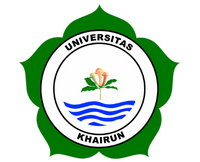Application of Liquid Organic Fertilizer Derived from Vegetable Waste and NPK on Sweet Corn Plants (Zea mays saccharata Sturt)
Abstract
Corn is an alternative crop that replaces staple foods other than rice. Efforts to increase corn production in less fertile land with the application of liquid organic fertilizer (POC) vegetable waste and NPK provide nutrients and improve soil structure so that roots develop well. This study aims to obtain the right POC and NPK dose to increase the growth and production of sweet corn. The method used is field experiments. The layout on the field uses a Split Plot Design with 12 combinations repeated 3 times. The size of the plot is 2 x 2 m. As the main plot, namely NPK fertilizer K1 (30 g/plot), K2 (60 g/plot), and K3 (90 g/plot). As a subplot, namely POC of vegetable waste P0 (0 ml/L), P1 (10 ml/L) P2 (20 ml/L), and P3 (30 ml/L). The application of POC 30 ml/L with NPK fertilizer 30 g/plot is the best combination of treatment in increasing production by 12.6 kg/plot or 25.20 tons/ha.
Full Text:
PDFReferences
Alim N., Simarmata M.M.T, Gunawan B., Purba T, Juita N, Herawati J., Firgiyanto R., Juniariah, dan Inayah AR. 2022. “Pengelolaan Lahan Kering”. Medan: Yayasan Kita Menulis.
Dailami A., Yetti H., dan Yoseva S. 2015. “Pengaruh Pemberian Pupuk Kascing dan NPK terhadap pertumbuhan dan Produksi Tanaman Jagung manis (Zea mays Var saccharata Sturt)”. Jurnal Online Mahasiswa Fakultas Pertanian, Vol. 2 No.2 hal. 1-12.
Chasanah N., Purnamasari R.T., dan Arifin A.Z. 2018. “Pengaruh Konsentrasi Pupuk Organik Cair terhadap Pertumbuhan dan Produksi Tanaman Jagung Manis (Zea mays sachharata Sturt)”. Jurnal Agroteknologi Merdeka Pasuruan, Vol. 2 No. 2 hal. 1-7.
Mahdiannoor M., Istiqomah N., dan Syarifuddin S. 2016. “Aplikasi Pupuk Organik Cair terhadap Pertumbuhan dan Produksi Tanaman Jagung Manis”. Zira’ah Jurnal Ilmu-Ilmu Pertanian, Vol. 41 No. 1 hal. 1-10.
Marsono dan Linga P. 2013. “Petunjuk Penggunaan Pupuk”. Bandung: Penebar Swadaya.
Prasetyo D., dan Evizal R. 2021. “Pembuatan dan Upaya peningkatan Kualitas Pupuk Organik Cair”. Jurnal Agrotropika Vol. 20 No. 2 hal. 68-80.
Pratikta D., Hartatik S., dan Anom K. 2013. “Pengaruh Penambahan Pupuk NPK terhadap Produksi beberapa aksesi tanaman jagung manis (Zea mays L)”. Berkala Ilmiah Pertanian, Vol. 1 No.2 hal. 19-21.
Sutoyo. 2019. “Pemanfaatan Limbah Sayur sebagai Bahan Baku”. Penamas Adi Buana, Vol. 2 No. 3 hal. 487-492.
Sitepu A., dan Adityawarman. 2017. “Respon Pertumbuhan dan Produksi Jagung manis terhadap limbah padat pabrik kelapa sawit dan NPK”. JOM FEPERTA, Vol. 4 No.2 hal. 1-12.
Syofia L., Munar A., dan Sofyan M. 2014. “Pengaruh POC terhadap Pertumbuhan dan hasil dua Varietas Tanaman Jagung manis (Zea mays sachharata Sturt)”. Jurnal Agrium, Vol. 18 No.3 hal. 208-218.
Wirayuda B., dan Koesriharti. 2020. “Pengaruh Permberian Pupuk Organik dan Pupuk Anorganik terhadap Pertumbuhan dan Hasil Tanaman Jagung Manis (Zea mays sachharata L)”. Jurnal Produksi Tanaman, Vol. 8 No.1 hal. 201-209.
Yosefa S., dan Hartanti I. 2014. Phosphate terhadap Pertumbuhan dan Produksi Jagung Manis (Zea mays saccharata Sturt). Seminar Nasional BKS PTN Barat Bandar Lampung, hal. 19-21.
DOI: https://doi.org/10.32502/jgsa.v4i2.8318
Refbacks
- There are currently no refbacks.
Indexed by:
Journal of Global Sustainable Agriculture
Diterbitkan oleh Fakultas Pertanian, Universitas Muhammadiyah Palembang
Contact Person:
Rika Puspita Sari, M.Si (+62 813-7490-0341)
Klinik Publikasi Pertanian
Faculty of Agriculture, Universitas Muhamamdiyah Palembang
JL. Jend. A. Yani 13 Ulu Palembang, South Sumatra, Indonesia
Tel. (+62)711-511731; Email: kppfpump@gmail.com; Website: https://jurnal.um-palembang.ac.id/JGSA

This work is licensed under a Creative Commons Attribution 4.0 International License.







1.png)

13.png)





